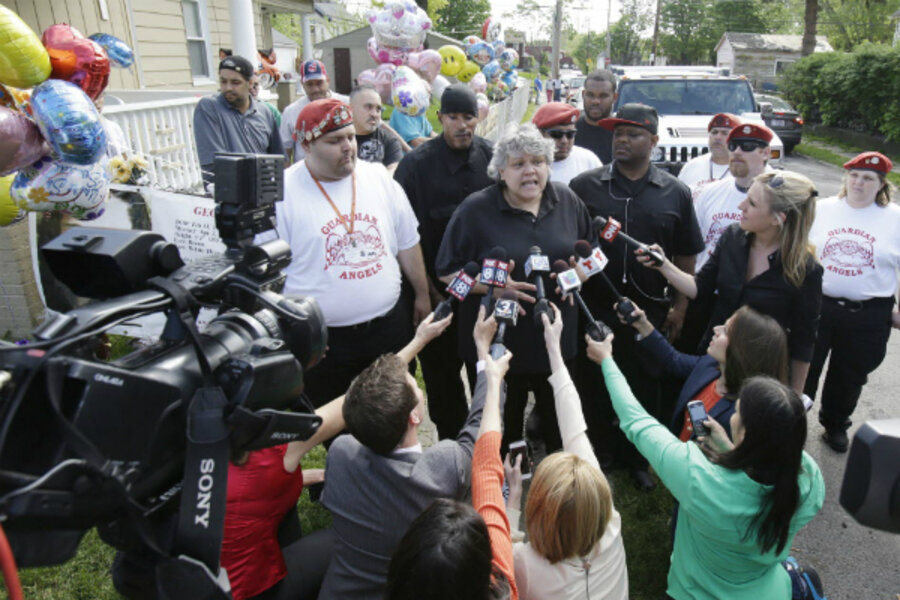Police ask how three women in Cleveland kidnapping went undetected so long
Loading...
Cleveland police on Monday night arrested three brothers in connection with kidnapping and holding captive three women for the past decade – a situation that left neighbors wondering why they had not noticed suspicious activity.
Suspect Ariel Castro owns the house where Amanda Berry, Gina DeJesus, and Michelle Knight were held captive for about 10 years until Ms. Berry escaped Monday evening and called 911, Police Chief Michael McGrath said at a news conference Tuesday morning. Mr. Castro’s brothers – Pedro Castro and Onil Castro – were also arrested, though they do not live at the house.
Berry identified Ariel Castro as her captor in her frantic 911 call Monday evening, according to the call transcript. Police say they believe they have the right people in custody, but the investigation could take many weeks.
“We have several unanswered questions,” said Cleveland Mayor Frank Johnson at a press conference Tuesday. “Why were they taken? How were they taken? And how did they remain undetected in the city of Cleveland for this period of time?”
Neighbors on Seymour Avenue on the west side of Cleveland are surprised that the women were found in the house of Castro, a nice guy who attended neighborhood barbecues and offered kids rides on his four-wheeler.
“I'm not the only one on the block that feels ashamed to know that we didn't notice anything,” Juan Perez, who grew up two houses down the block, told WEWS-TV Monday night. “I mean, I feel like my head's low, I work at a school, I work with kids ... I have a heavy heart right now.”
Another neighbor said he never saw women or girls at the house, and there was no indication that people were being held against their will – only Castro doing “average” things.
“He just comes out to his backyard, plays with the dogs, tinkering with his cars and motorcycles, [and goes] back in the house,” Charles Ramsey, a neighbor, told WEWS-TV Monday. “There’s nothing exciting about him. Well, until today.”
But Mr. Perez said he now realizes that Castro did display some odd behavior – such as stopping at home for only 10 minutes or an hour – and he speculated that the suspect owned other property, which police are investigating.
The FBI collected evidence from the crime scene throughout the night, and the next step will be to piece together 10 years of logistical information, Mr. McGrath said at the news conference.
There is no evidence in city databases that anyone living near the house called authorities about suspicious activity, city Public Safety Director Martin Flask told the Cleveland Plain Dealer. There are also no code violations on the house or calls made to the fire department.
Police visited the house twice in the past 15 years: In 2000, Castro called the police to report a fight, but no arrests were made, and police visited the house in 2004 because, as a school bus driver, Castro left a child unattended on the bus. No one answered the door, and police said there was no criminal intent.
Castro's uncle, Julio, who owns a grocery store half a block from the house on Seymour Avenue, said Castro worked as a school bus driver. Cleveland Metropolitan School District spokesperson Roseann Canfora confirmed that Castro worked as a school bus driver but did not have details about the duration of his employment or whether he left voluntarily or was fired.
It’s unknown whether Castro allegedly gained the three women’s trust through his job as a bus driver, said Cleveland Deputy Police Chief Ed Tomba at the press conference Tuesday.
"That's up to the girls to tell us," he said. "We still don't know; that is one of the great unknowns right now. We anticipate getting that information from the ladies, not the suspects."
The Castro family grew up in the same west side Cleveland neighborhood and knew the DeJesus family, Julio Castro told CNN.
Mr. Tomba said that the police and FBI are interviewing members of the Castro family, but they are not at liberty to release any information gained from those conversations. He said the police are working with the prosecutor’s office to file charges within 36 hours from the suspects’ arrest.
• Material from the Associated Press contributed to this report.









